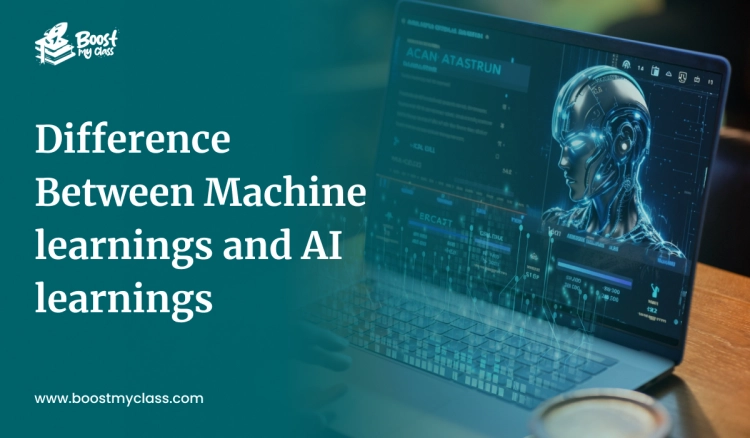Difference Between Machine Learnings and AI Learnings

Welcome to our article on the difference between machine learning and AI learning. In the rapidly growing field of artificial intelligence, understanding these two ideas is essential to stay ahead. Whether you’re seeking online class help or to develop your expertise in machine learning and AI learning, this article will provide you with useful insights.
Key Takeaway
- Machine learning focuses on developing algorithms and models that enable computers to learn from experience.
- AI learning encompasses the broader concept of creating machines that can mimic human intelligence.
- Machine learning and AI learning have specific characteristics, techniques, and goals that set them apart.
- Machine learning is widely uses in various industries, from self-driving cars to personalized recommendations.
- AI learning finds applications in virtual assistants, natural language processing, and cutting-edge technologies.
What is Machine Learning?
Machine learning is a branch of Artificial Intelligence (AI) that focuses on developing algorithms and standards allowing computers to learn and improve from knowledge. By exploring extensive amounts of data, machine understanding algorithms can automatically recognize patterns, make predictions, and make informed conclusions without direct programming.
Machine learning algorithms depend on statistical methods and mathematical examples like Take My Exam to iteratively learn from data and optimize their implementation over time. These algorithms can be trained to complete specific tasks such as image honor, natural language processing, and guidance systems.
Key Principles of Machine Learning:
- Supervised Learning: Algorithms learn from labeled and annotated data to make predictions or categorize new data points.
- Unsupervised Learning: Algorithms learn from unlabeled data to identify hidden patterns or group similar data points together.
- Reinforcement Learning: Algorithms learn through trial and error by receiving feedback and rewards for performing actions in a given environment.
Machine learning has revolutionized different initiatives, including finance, healthcare, e-commerce, and marketing. Its applications range from scam detection and personalized guidance to autonomous vehicles and virtual helpers.
Exploring AI Learning
AI learning moves beyond machine knowledge and contains the more general idea of creating devices that can simulate human brains. It affects the growth of algorithms and norms that enable computers to perform tasks requiring human-like intelligence, such as comprehending natural language, recognizing patterns, and making decisions.
AI learning has multiple applications across different industries, including healthcare, finance, and transportation. In healthcare, AI systems can interpret medical data to help in analyzing diseases and suggesting remedies. In finance, AI algorithms can study market trends and make buy decisions. In transportation, AI-powered autonomous vehicles can guide the roads and make real-time conclusions based on their surroundings.
While AI learning has the possibility to revolutionize enterprises and improve our daily lives, it also faces certain limitations. One main challenge is the absence of explainability in AI systems. Unlike conventional software, AI systems usually arrive at conclusions based on complicated algorithms that are tough to interpret. This lack of clarity raises concerns about the dependability and ethical implications of AI technology.
Key Differences Between Machine Learning and AI Learning
Understanding the differences between machine learning and AI learning is essential for gaining a better grasp of how these two methods vary, not going for the Take My Online Class help. While both fields drop under the general umbrella of artificial intelligence, they have different characteristics, techniques, and goals. Let’s delve into the specifics and emphasize the key differences between machine learning and AI learning.
Machine Learning
Machine learning is a subset of AI that focuses on developing algorithms and samples that promote computers to learn and improve from experience. It involves exercise machines to analyze data, recognize patterns, and make forecasts or conclusions without being explicitly programmed. The primary goal of machine learning is to create representatives that can perform specific tasks accurately and efficiently.
AI Learning
AI learning, on the other hand, contains the more general concept of creating machines that can imitate human intelligence. It involves simulating human mental processes like perception, logic, learning, and problem-solving. AI learning combines various technologies, including machine learning, natural language processing, computer vision, and robotics, to build approaches that can perform tasks with human-like intelligence.
Key Differences
- Scope: Machine learning focuses on training machines to perform specific tasks based on patterns in data, while AI learning aims to create machines with human-like cognitive abilities.
- Approach: Machine learning relies on algorithms and statistical models, whereas AI learning integrates multiple technologies to mimic human cognitive processes.
- Goals: The primary goal of machine learning is to develop accurate and efficient models for specific tasks, while AI learning seeks to create intelligent machines capable of complex problem-solving and decision-making.
By understanding the discrepancies between machine learning and AI learning, you can better appreciate the special attributes and applications of each approach. Whether you’re digging career prospects, developing AI solutions, or simply aiming to expand your knowledge, this knowledge will help you guide the rapidly becoming world of artificial intelligence.
Benefits and Challenges of Machine Learning and AI Learning
Executing machine learning and AI learning offers multiple benefits for various initiatives. These technologies have the possibility to revolutionize techniques, enhance decision-making, and push invention. However, along with their benefits, there are also challenges that must to be addressed to provide responsible and moral use.
In order to fully harness the benefits of machine learning and AI learning while mitigating potential risks, it is crucial to address these challenges through responsible implementation, continuous monitoring, and ongoing research in the field.
Conclusion
Understanding the differences between machine learning and AI learning is essential for anyone curious in the field of hypocritical intelligence. Machine learning focuses on developing algorithms and models that allow computers to understand and improve from adventure, while AI learning encompasses creating machines that can mimic human intelligence.
I am a Natural sciences enthusiast with a profound passion for Biology, Chemistry, Statistics, and Physics. Completed more than 1055+ online classes and exams for the students. So they score high and stress less!
Discount
On Your First Order




